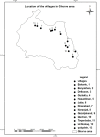Evaluating the spatial distribution of quantitative risk and hazard level of arsenic exposure in groundwater, case study of Qorveh County, Kurdistan Iran
- PMID: 23574885
- PMCID: PMC3642021
- DOI: 10.1186/1735-2746-10-30
Evaluating the spatial distribution of quantitative risk and hazard level of arsenic exposure in groundwater, case study of Qorveh County, Kurdistan Iran
Abstract
Regional distribution of quantitative risk and hazard levels due to arsenic poisoning in some parts of Iran's Kurdistan province is considered. To investigate the potential risk and hazard level regarding arsenic-contaminated drinking water and further carcinogenic and non-carcinogenic effects on villagers, thirteen wells in rural areas of Qorveh County were considered for evaluation of arsenic concentration in water. Sampling campaign was performed in August 2010 and arsenic concentration was measured via the Silver Diethyldithiocarbamate method. The highest and lowest arsenic concentration are reported in Guilaklu and Qezeljakand villages with 420 and 67 μg/L, respectively. None of thirteen water samples met the maximum contaminant level issued by USEPA and Institute of Standards and Industrial Research of Iran (10 ppb). The highest arsenic concentration and consequently risk and hazard levels belong to villages situated alongside the eastern frontiers of the county. Existence of volcanic activities within the upper Miocene and Pleistocene in this part of the study area may be addressed as the main geopogenic source of arsenic pollution. Quantitative risk values are varying from 1.49E-03 in Qezeljakand to 8.92E-03 in Guilaklu and may be interpreted as very high when compared by similar studies in Iran. Regarding non-carcinogenic effects, all thirteen water samples are considered hazardous while all calculated chronic daily intakes are greater than arsenic reference dose. Such drinking water source has the potential to impose adverse carcinogenic and non-carcinogenic effects on villagers. Accordingly, an urgent decision must be made to substitute the current drinking water source with a safer one.
Keywords: Arsenic; Drinking water; Groundwater; Hazard; Qorveh; Risk.
Figures




Similar articles
-
Assessment of heavy metal contamination in groundwater of rural areas of Kurdistan Province Iran: A comprehensive study.Heliyon. 2024 Oct 28;10(21):e39833. doi: 10.1016/j.heliyon.2024.e39833. eCollection 2024 Nov 15. Heliyon. 2024. PMID: 39553600 Free PMC article.
-
Arsenic health risk assessment and the evaluation of groundwater quality using GWQI and multivariate statistical analysis in rural areas, Hashtroud, Iran.Environ Sci Pollut Res Int. 2021 Jan;28(3):3617-3631. doi: 10.1007/s11356-020-10710-6. Epub 2020 Sep 14. Environ Sci Pollut Res Int. 2021. PMID: 32929669
-
Arsenic in the rock-soil-plant system and related health risk in a magmatic-metamorphic belt, West of Iran.Environ Geochem Health. 2020 Nov;42(11):3659-3673. doi: 10.1007/s10653-020-00599-y. Epub 2020 May 21. Environ Geochem Health. 2020. PMID: 32440917
-
[Probabilistic Risk Assessment of Arsenic Exposure Through Drinking Water Intake in Chinese Residents].Huan Jing Ke Xue. 2021 Jul 8;42(7):3338-3347. doi: 10.13227/j.hjkx.202010116. Huan Jing Ke Xue. 2021. PMID: 34212659 Chinese.
-
Sources, pathways, and relative risks of contaminants in surface water and groundwater: a perspective prepared for the Walkerton inquiry.J Toxicol Environ Health A. 2002 Jan 11;65(1):1-142. doi: 10.1080/152873902753338572. J Toxicol Environ Health A. 2002. PMID: 11809004 Review.
Cited by
-
Origin and assessment of groundwater pollution and associated health risk: a case study in an industrial park, northwest China.Environ Geochem Health. 2014 Aug;36(4):693-712. doi: 10.1007/s10653-013-9590-3. Epub 2013 Dec 18. Environ Geochem Health. 2014. PMID: 24346317
-
Large-scale association analysis of climate drought and decline in groundwater quantity using Gaussian process classification (case study: 609 study area of Iran).J Environ Health Sci Eng. 2018 May 19;16(2):129-145. doi: 10.1007/s40201-018-0301-y. eCollection 2018 Dec. J Environ Health Sci Eng. 2018. PMID: 30728986 Free PMC article.
References
-
- Agency for toxic substances and disease registry (ATSDR) 2009. [ http://www.atsdr.cdc.gov/]
-
- Integrated Risk Information System (IRIS): 2009, USEPA. [ http://www.epa.gov/iris/]
-
- Chiou HY, Hsueh YM, Liaw KF, Horng SF, Chiang MH, Pu YS, Lin JSN, Huang CH, Chen CJ. Incidence of internal cancers and ingested inorganic As: a seven-year follow-up study in Taiwan. Cancer Res. 1995;55:1296–1300. - PubMed
LinkOut - more resources
Full Text Sources
Other Literature Sources
Miscellaneous

